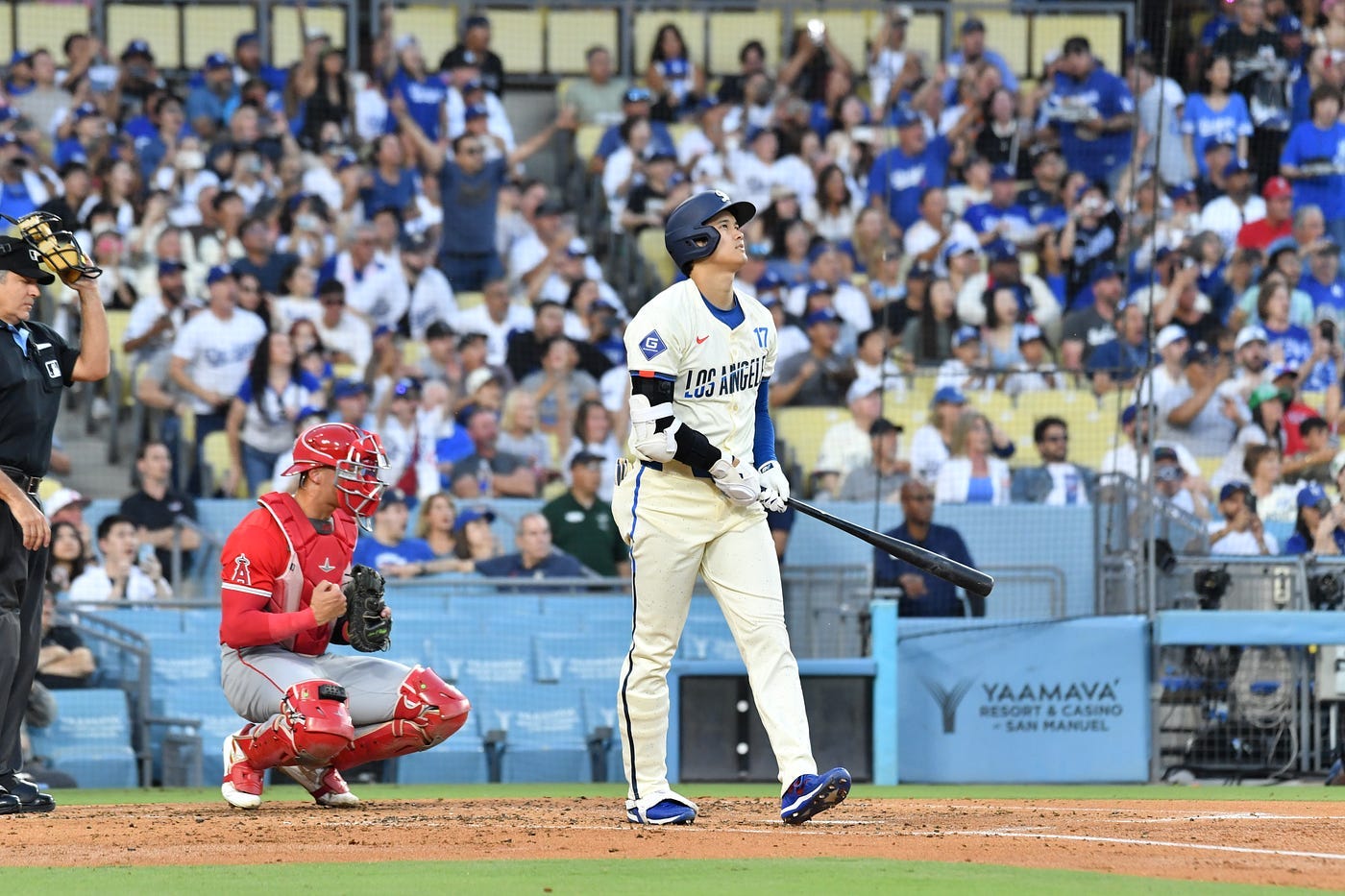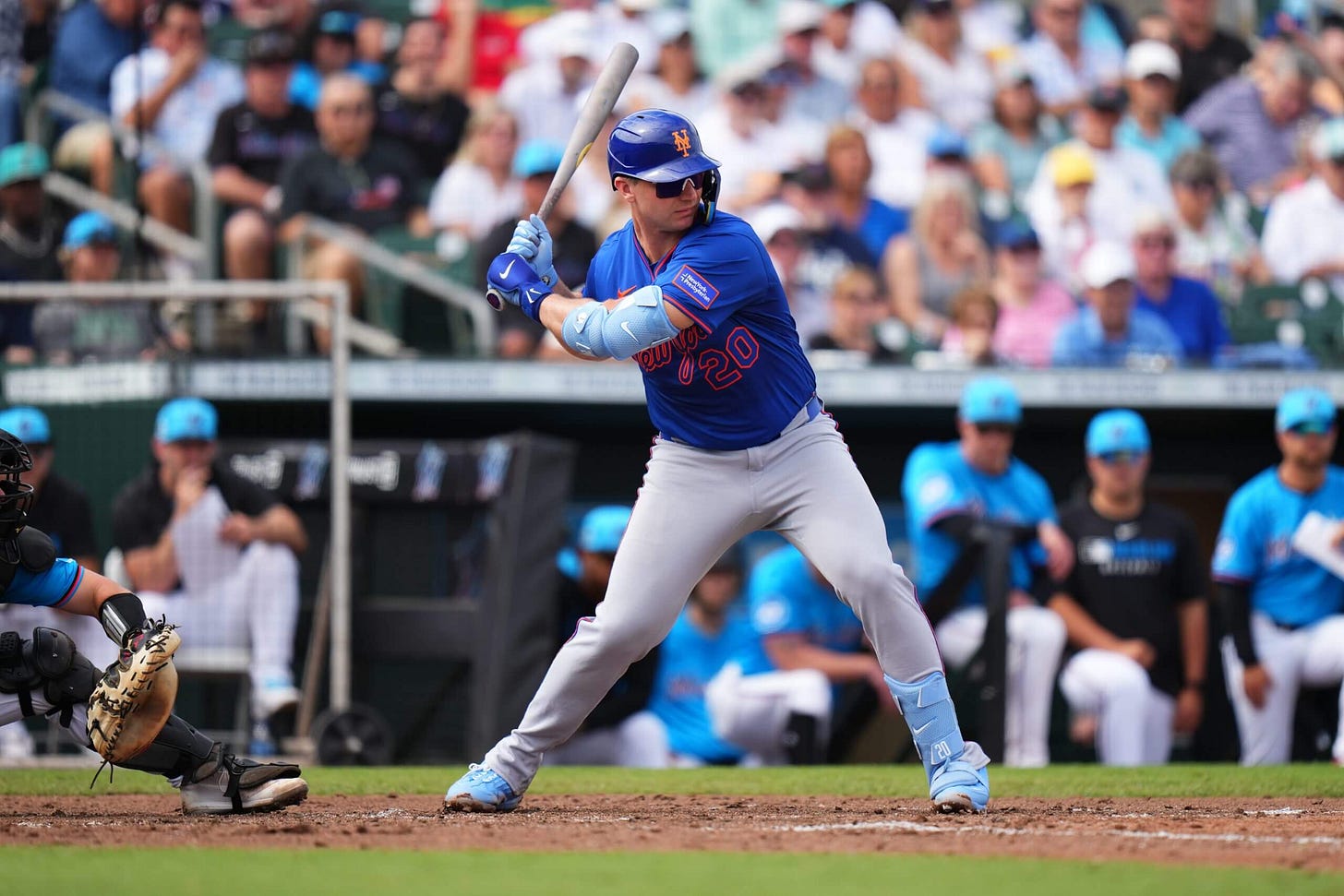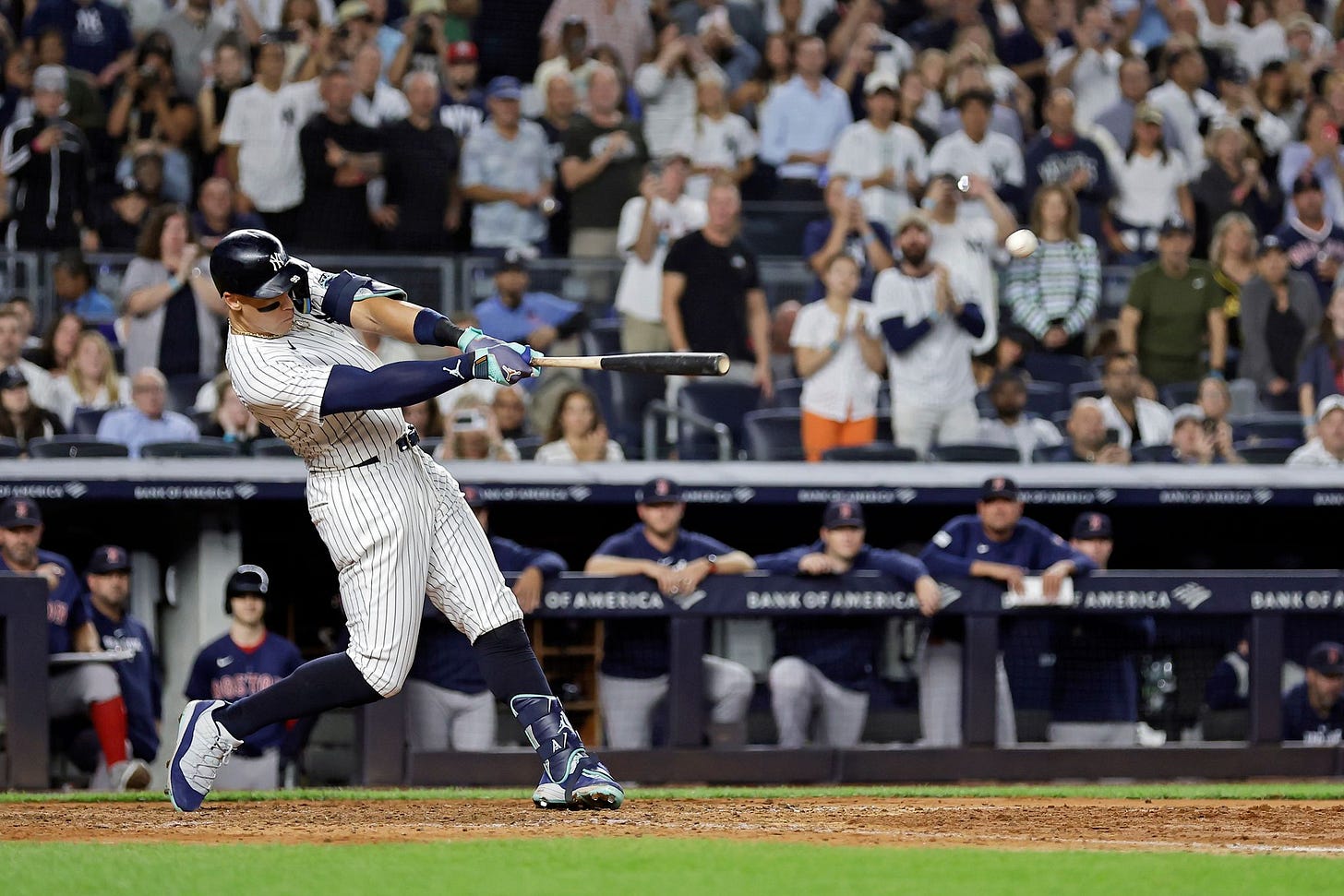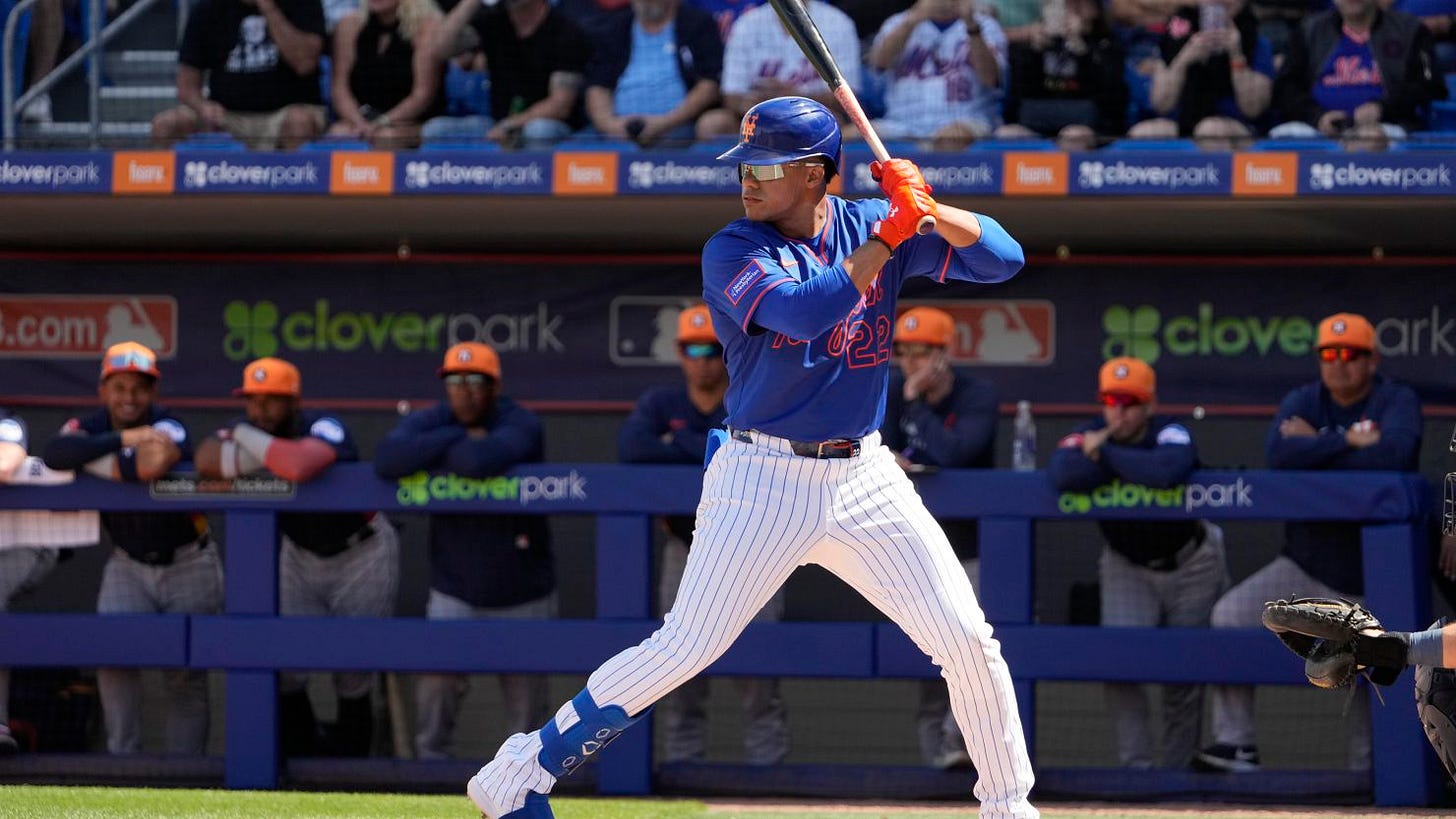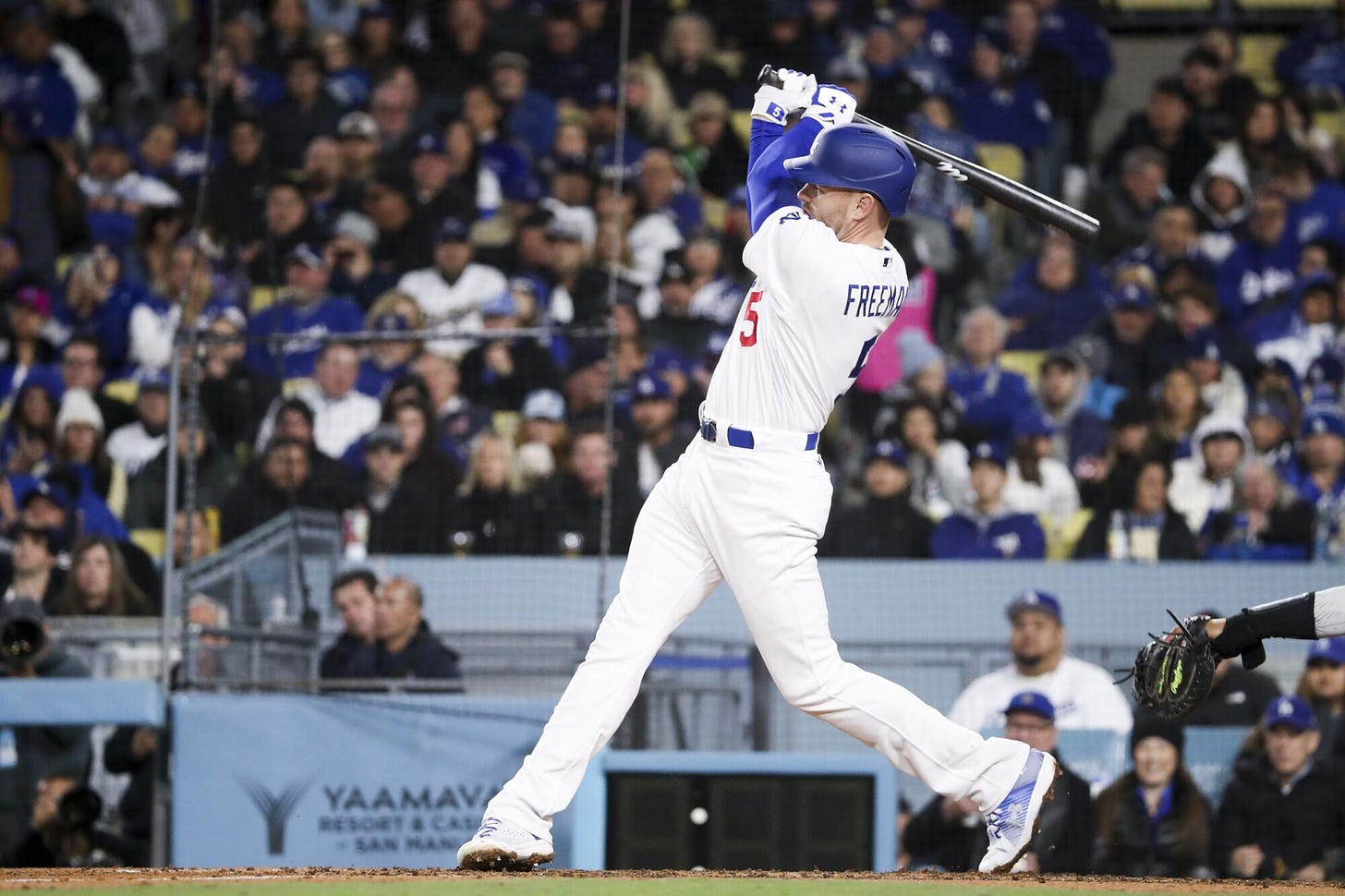Exploring Key Metrics and Methodology for Analyzing Offensive Performance - 2025 Update
How to evaluate offensive players using advanced metrics.
Back in 2023, I wrote a piece on my Medium blog titled Exploring Key Metrics and Methodology for Analyzing Offensive Performance. The goal of the article was to both explain my process for evaluating hitters, as well as to organize my thoughts to improve my evaluation process. Last year, I decided it would be beneficial to annually update this article to document how my evaluation process has evolved over the past year, and this article has become one that I look forward to each year. Some of this article will be copied and pasted from the original, however, I have added a new section discussing the updates in bat tracking which have made significant advancements over the past year, along with other adjustments.
Evaluating a hitter’s offensive performance can be one of the most comprehensive forms of baseball analysis, as multiple facets of a hitter’s approach such as plate discipline, batted-ball quality, and “luck factors” all need to be analyzed to fully understand how a hitter’s offensive production is created. Analyzing offensive players’ performance took a big leap once Statcast data was released to the general public, and is currently undergoing another evolution as the public sphere is grasping a better understanding of bat tracking data, demonstrating the ever-changing nature of baseball analytics and the need to constantly adapt to effectively evaluate hitters. In this article, I break down my process for evaluating offensive players, explain how I utilize publicly available advanced metrics, and discuss how my process of analyzing hitters has changed over the past year.
Descriptive Metrics:
In my opinion, Weighted Runs Created Plus (wRC+) is the most powerful, all-encompassing metric for evaluating offensive players. As described by FanGraphs, “Weighted Runs Created Plus (wRC+) is a rate statistic which attempts to credit a hitter for the value of each outcome (single, double, etc.) rather than treating all hits or times on base equally, while also controlling for park effects and the current run environment.” wRC+ is typically the first offensive metric I look at while evaluating a Major League player because it is the best statistic at evaluating a player’s total offensive production, due to the statistic’s strong correlation with runs scored.
While wRC+ provides great insight into how well an offensive player is performing, there are other metrics available that better describe why an offensive player is performing at a certain level. Two statistics I use to determine whether or not a player is experiencing “batted ball luck”, are xwOBA (Expected Weighted On-Base Average) and BABIP (Batting Average on Balls in Play).
BABIP (Batting Average on Balls in Play) was one of the first sabermetrics created to identify whether or not a batter was experiencing “batted ball luck” and producing a higher/lower batting average than expected. Similar to the mathematical concept of regression to the mean, the league average for BABIP remains at or around .300 each season. Therefore, it is assumed that an individual player’s BABIP will stabilize at .300 over the course of a full season. If a player’s BABIP is at .450 for example, it can be expected that the player’s batting average will sharply decline over the remainder of the season as the BABIP regresses to the league average. However, there are some flaws to BABIP, as some players do not consistently average a .300 BABIP. Players that hit a lot of line drives, such as Freddie Freeman, hit the ball very hard, such as Aaron Judge, or have high sprint speeds, such as Trea Turner, tend to have BABIP’s above league average; while players that hit an excessive amount of fly balls tend to have BABIP’s below league-average.
xwOBA (Expected Weighted On-Base Average) attempts to remove the subjectivity of interpreting BABIP when it comes to evaluating the “luck factor” of offensive players. xwOBA is formulated by using exit velocity, launch angle, and sprint speed to predict a hitter’s wOBA (Weighted On-Base Average). Similar to wRC+, wOBA is “a rate statistic which attempts to credit a hitter for the value of each outcome (single, double, etc.) rather than treating all hits or times on base equally”, as described by FanGraphs. If a player’s xwOBA is higher than their wOBA, it can be assumed that the hitter is experiencing “batted ball luck”, while if a player’s xwOBA is lower than their wOBA, then it can be assumed that the hitter has been “unlucky”.
While it appears on the surface that comparing xwOBA to wOBA as opposed to evaluating BABIP might be more effective at identifying “batted ball luck” (due to the apparent removal of subjectivity in the analysis compared to BABIP), there are a couple of shortcomings to xwOBA which make this comparison a bit more nuanced. First, xwOBA was designed to be a descriptive metric within a given season. Using xwOBA to evaluate a player's “batted ball luck” assumes that their batted ball quality will remain consistent throughout the entirety of the season, which is not always the case. Second, xwOBA (for reasons described by Tom Tango) does not include spray angle in its calculation. This causes players that frequently pull fly balls (such as Isaac Parades) to be consistently undervalued by xwOBA as the statistic does not take into account the different levels of exit velocity required to create offensive production at various spray angles.
For these reasons, I believe it is important to use both xwOBA/wOBA and BABIP in tandem when it pertains to evaluating “batted ball luck”. Being able to understand the shortcomings and limitations of each metric which can allow for hitters to over/underperform their expected production is a critical step in evaluating offensive performance.
Batted Ball Metrics:
Since the advent of the Statcast era in 2015, the public has had access to a variety of metrics evaluating the exit velocity and launch angle of batted balls, which serve as predictive metrics to determine an offensive player’s potential. The most commonly cited batted ball metrics that are used to evaluate a player’s offensive performance are Hard Hit%, Barrel%, and Max. Exit Velocity, which are easily found on each player’s Baseball Savant page.
Over the past few seasons, I have used these three metrics as the foundation for analyzing each hitter’s batted ball quality because they answer the following important questions:
Does the player hit the ball hard? (Hard Hit%)
Does the player hit the ball hard at optimal angles? (Barrel%)
What is the player’s “raw power”? (Max. EV)
If a player has a high Hard Hit% and low Barrel%, perhaps they are not hitting the ball in the air frequently. If a player has a high Max. EV but low Hard Hit%, perhaps a mechanical and/or approach change is needed for a player to consistently access their raw power in-game. While the ease of obtaining these metrics on Baseball Savant has allowed for the “big 3” of Hard Hit%, Barrel%, and Max. EV to be frequently used for analysis of offensive players, recent research has suggested that there are better metrics available for quantifying these aspects of a hitter’s profile.
First, I have largely stopped utilizing Hard Hit% to measure a player’s ability to hit the ball hard, instead utilizing EV50 (also referred to as Best Speed). Hard Hit% is the percentage of batted balls a player hits that possess an exit velocity of at least 95 MPH, which Statcast defines as the threshold where exit velocity begins to “matter” in terms of its effect on batted ball performance. I typically view a player who has a Hard Hit% of at least 40% to be someone who “hits the ball hard”, with values over 50% to be “exceptional” (the average MLB Hard Hit% is ~36%).The main flaw behind Hard Hit% is that it treats all batted balls over 95 MPH equally, while in reality, a batted ball hit over 110 MPH has a significantly different expected outcome than a batted ball hit between 95-100 MPH. In addition, players who frequently hit batted balls around the 95 MPH threshold could possess a very high Hard Hit%, giving the analyst the impression that their power output is higher than reality and/or resulting in significant year-to-year fluctuations.
For this reason, I have begun to use EV50 instead of Hard Hit% to analyze a player’s ability to consistently hit the ball hard. Created by Tom Tango, EV50 calculates the average exit velocity of a player’s 50% hardest-hit balls, removing the variance caused by weakly-hit balls in other average metrics such as Average Exit Velocity. I was first introduced to the concept of EV50 by an article written by Dave Andrews of FanGraphs in 2023 titled "The Doomed Search for a Perfect Way To Interpret Exit Velocity Data”. As discussed in the article, EV50 has a stronger year-to-year correlation to wOBAcon than Hard Hit% and Avg. Exit Velocity, displaying that the metric performs the best at identifying a hitter’s “true talent” ability to hit the ball hard. EV50 is also easy to interpret, as the league average typically hovers around 100 MPH (values over 100 are above average, and values below 100 are below average). While EV50 is unfortunately not present on each player’s Savant page (I think it should replace Avg. EV!), this data can be easily viewed on Savant’s Exit Velocity and Barrels leaderboard.
To measure a player’s raw power and potential power upside, I used to frequently utilize Max. Exit Velocity, which is simply the exit velocity value of a batter's hardest-hit ball in a given season. Looking back at my 2023 article, it looks like I placed quite a heavy emphasis on Max. EV, which makes sense considering that it is easily available throughout the Baseball Savant website. Max. EV can be useful, but it has a notable flaw in that it only considers one batted ball that a batter has hit in a given season, which intuitively suggests that the metric might not be the most effective in terms of predictive power.Instead of using Max. EV to measure a player’s raw power, I have begun to utilize EV90, which is each player’s 90th percentile exit velocity value. Simply put, EV90 is more stable year-to-year than Max. EV, providing analysts with a more reliable measure of a player’s power upside. Both Ben Clemens and Jeremy Siegel have conducted notable analysis regarding the effectiveness of percentile-based exit velocity metrics, and my research suggests that EV90 possesses the best balance of year-to-year stability and predictive power with wOBAcon among the various percentiles.
To measure which hitters produce the hardest contact at the most optimal angles, Barrel Rate continues to reign supreme. As defined by Statcast, a Barrel is a “batted ball event whose comparable hit types (in terms of exit velocity and launch angle) have led to a minimum .500 batting average and 1.500 slugging percentage since Statcast was implemented Major League wide in 2015.” In simpler terms, “to be Barreled, a batted ball requires an exit velocity of at least 98 MPH. At that speed, balls struck with a launch angle between 26-30 degrees always garner Barreled classification. For every MPH over 98, the range of launch angles expands.” Perhaps the advent of expanded bat tracking metrics (which will be discussed later) will result in a new Barrel Rate-like metric, however, at the present moment, Barrel Rate is the best metric to utilize to identify which hitters produce the hardest contact at the most optimal angles.
In my opinion, launch angle is one of the most misunderstood Statcast metrics by the general public, and while it has numerous effective uses, the metric can often be misutilized. One general misconception about launch angle is that hitters should always attempt to make contact at a specific high angle, which will in turn guarantee offensive success due to the amount of production a batter will produce. While hitting the ball in the air is a very good objective for most hitters to strive for, it is easy to see by looking at the Statcast leaderboards that there is little to no correlation between Avg. Launch Angle and total offensive production. This is largely because different launch angles are ideal for different parts of the zone, and research by Alex Chamberlain indicates that pitchers have a large amount of control over a hitter’s launch angle. Given these factors, I prefer to utilize launch angle in combination with exit velocity and the location/quality of the pitch, rather than as an isolated metric.
Plate Discipline Metrics:
Having good plate discipline is a skill I look for in offensive players for a variety of reasons. One, swinging at “good” pitches and not swinging at “bad” pitches often results in higher-quality contact. Two, having the ability to walk at a high rate not only adds to a player’s total offensive production but also provides the hitter with a “safety net” to fall back on during a slump, as they are still able to consistently get on-base.
There are a few methods I use for evaluating plate discipline. One method I use is simply analyzing the player’s walk rate. Since a player needs to take 4 pitches out of the zone to draw a walk, a high walk rate is a clear indicator that a hitter has good plate discipline. Analyzing a player’s walk rate alongside their strikeout can be an effective method for evaluating Minor League prospects, if a player displays high walk rates and low strikeout rates in the Minors, it can be indicator that the player will experience Major League success. On the other hand, if a prospect has a high strikeout rate at a lower level like A-ball, they will likely swing-and-miss too much against advanced pitching to reach the 26-man roster.
High walk rates can sometimes be a deceiving measure of plate discipline, as hitters can accumulate walks by simply being passive at the plate, especially in the Minor Leagues where the quality of pitching results is lower than in the Majors. To account for this, a more effective method of measuring a hitter’s plate discipline is by analyzing their O-Swing% (also referred to as Chase Rate), which measures how often a player swings at pitches outside of the strike zone. O-Swing% can be a better measure of a plate discipline than simply looking at a hitter’s walk rate because this metric takes into account all swing decisions, as opposed to walk rate which only takes into account the swing decision made on the last pitch of a given plate appearance.
Over the past couple years, swing decision models have attempted to take this analysis one step further by properly weighing the value of a swing vs. a take to better evaluate a hitter’s plate discipline. Two notable models that I have referred to often are Drew Haugen’s SwRV+, and Robert Orr’s SEAGER. I have also attempted to create a swing decision model, inspired by these two models. Swing decision models are an important next step in evaluating plate discipline because swings and takes have different values in different counts. A “bad” swing on a 3-2 count should be penalized more than a “bad” swing on a 2-0 count, and a swing decision on a pitch down the heart of the plate should be weighed differently than a pitch located on the edge of the strike zone. While it can be easy to attempt to “reinvent the wheel” with these models, the objective of a good swing decision model is to quantify how well a player doesn’t swing at balls and how well a player swings at strikes, and both models attempt to accomplish this task within their individual frameworks.
A player’s plate discipline is a skill that is widely thought to be “set in stone”, however, I believe there is a competitive advantage to be had if an organization develops a way to effectively improve a hitter’s swing decisions. Perhaps this could be achieved by using virtual reality training or a hyper-realistic pitching machine such as a Trajekt. Hitting is reactive and changing swing decision tendencies involves the difficult task of changing reactive habits that have been established over many years, but I think there is a lot of value to be gained if an organization can create a method to develop this skill effectively, even if it is just improving a hitter’s swing decisions by a couple percentage points, given the significant role the quality of a hitter’s swing decisions play in determining a player’s offensive ceiling.
Bat Tracking Metrics:
In 2023, I wrote a piece titled Examining the Future of Hitting: Bat Speed, Swing Path, and Biomechanics where I discussed how the availability of bat tracking data could be used to create better predictive metrics for offensive players and provide savvy organizations with a potential competitive advantage. In May 2024, Statcast released the first batch of bat tracking metrics (such as bat speed and swing length) to the public, and recently released attack angle and swing path metrics, allowing many analysts to begin creating new tools for analyzing offensive performance. While it is still very early to come to conclusions regarding how the newer data (attack angle, swing path tilt, and attack direction) can be leveraged to improve analysis of offensive players, the introduction of bat speed and squared-up rate have already played large roles in my process for evaluating offensive players.
Simply put, bat speed is an incredibly powerful metric to use in evaluating offensive hitters. Similar to how a pitcher who utilizes pitches at a higher velocity has a larger margin of error in terms of pitch shapes and location ability, the same is true for hitters who possess high bat speed. The relationship between bat speed and power production is evident with a simple look at Savant’s Bat Speed leaderboards, as the top of the leaderboard is filled with player’s who are considered to possess top-end power (Junior Caminero, Kyle Schwarber, Aaron Judge, etc.).
While bat speed does possess an evident relationship with power production, the value in the metric is its ability to stabilize quickly, with research indicating that average bat speed can become reliable in sample sizes as small as 3 swings. Batted ball metrics, such as Barrel% and EV50, usually take a longer time to stabilize compared to pitching metrics (such as Stuff+), given the fact that a batted ball event might not occur at each plate appearance. With bat tracking metrics providing information regarding the hitter on every swing (as opposed to every batted ball), analysis regarding the performance of offensive players can become more reliable earlier in the season utilizing these metrics.
Bat speed is a very important skill for a hitter to possess, however, it is not the only means to generate offensive production. Exit velocity is generated through (primarily) a combination of bat speed and collision efficiency, so players with a lower bat speed can still achieve ideal batted ball outcomes if they are able to “square-up” incoming pitches at a high rate. As defined by Statcast, a batted ball is “squared-up” if a swing attains at least 80% of the maximum potential exit velocity of the pitch, a proxy measurement for whether the ball made contact with the “sweet spot” of the bat. While players such as Luis Arraez, Steven Kwan, and Jacob Wilson, are all able to leverage their elite bat control abilities to “square-up” the baseball, resulting in elite squared-up rates and, in turn, above-average levels of offensive production.
Anecdotally, it appears that hitters typically either generate above-average bat speed or produce above-average squared-up rates. Offensive players that are able to generate plus bat speed and have an above-average feel for “squaring-up” the ball tend to be among the league’s best hitters (such as Juan Soto, Kyle Tucker, Shohei Ohtani, etc.), while players who are below-average in both categories likely need to possess top-end defensive value to generate organizational value.
As mentioned earlier, it is still very early to come to conclusions regarding how the newer data (attack angle, swing path tilt, and attack direction) can be leveraged to improve the analysis of offensive players, however, I am optimistic that this new data will bring the public one step closer to a Stuff+ style metric for offensive players. Both attack angle and swing path tilt appear to be quite sticky year-to-year, and it appears that in the near term, the data can be utilized to create new forms of analysis, such as modeling specific batter-pitcher matchups more effectively. There is a lot of potential in the future of predictive metrics for offensive players, and it will be interesting to see if any of the new bat tracking-related predictive metrics rival the effectiveness of the predictive metrics that have been created for analyzing pitchers over the past few seasons.
Concluding Thoughts:
With help from advanced metrics, baseball analysts now have more tools at their disposal than ever to both accurately evaluate hitters, and to identify how a hitter can improve their offensive approach in order to reach their full potential. Descriptive metrics such as wRC+, wOBA/xwOBA, and BABIP adjust a player’s offensive production relative for their environment, and attempt to quantify how much “luck” a hitter is encountering; while batted ball metrics such as exit velocity and launch angle use Statcast and Hawk-Eye technology to better evaluate a player’s offensive production. The continued rollout of bat tracking data such as bat speed, attack angle, swing path tilt, and squared-up rate, projects to have a significant impact on how analysts evaluate offensive production in the future. While scouting a player in person is still a very critical element of the player evaluation process, the usage of descriptive, batted ball, and bat tracking metrics can help analysts “paint a better picture” when determining how much offensive production a player produces, and aids heavily in forecasting a player’s potential future value.
Thanks for reading!
Follow @MLBDailyStats_ on X and Adam Salorio on Substack for more in-depth MLB analysis.
Photo credits to Juan Ocampo/Los Angeles Dodgers, Rich Storry/Getty Images, Associated Press, Jeff Roberson/Associated Press, Katie Stratman, Allen J. Schaben/Los Angeles Times.


